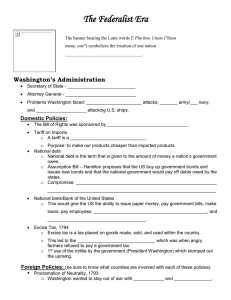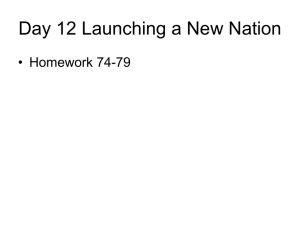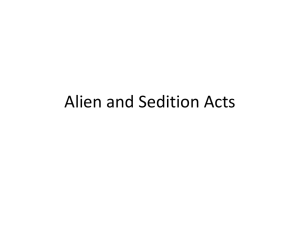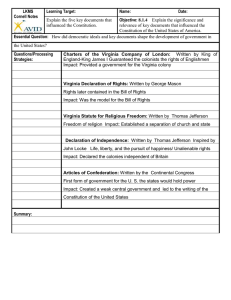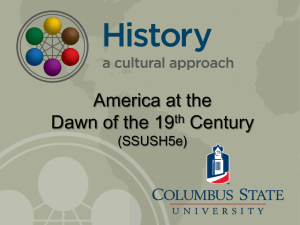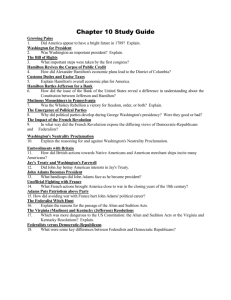The Federalist Era Washington’s Administration Domestic Policies:
advertisement
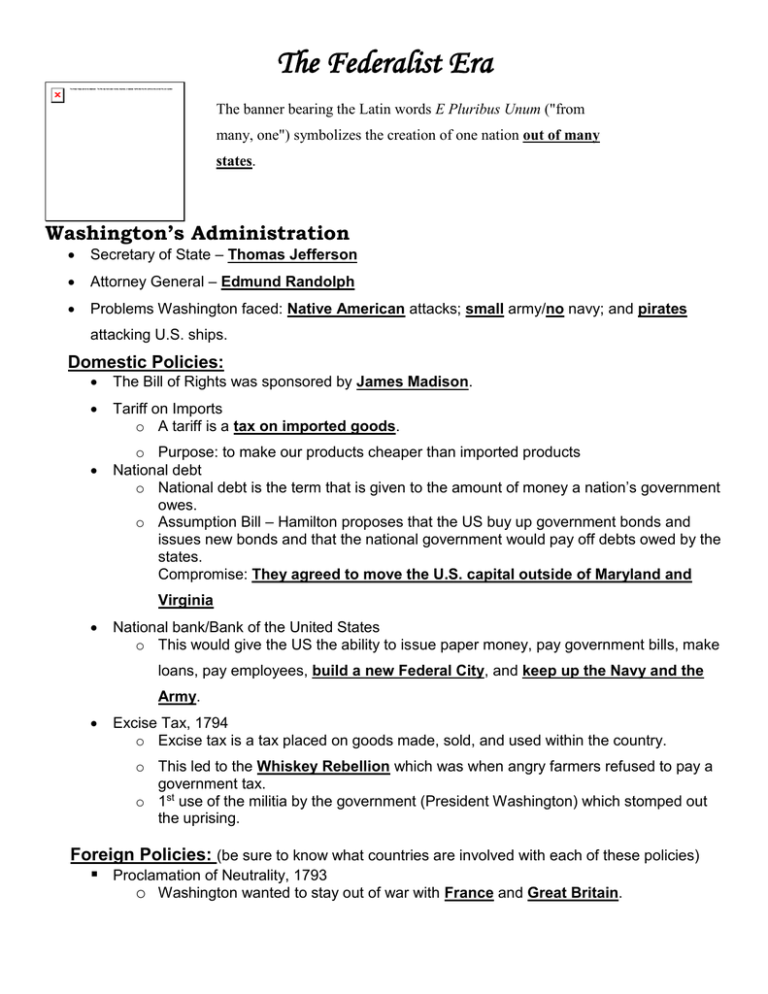
The Federalist Era The banner bearing the Latin words E Pluribus Unum ("from many, one") symbolizes the creation of one nation out of many states. Washington’s Administration Secretary of State – Thomas Jefferson Attorney General – Edmund Randolph Problems Washington faced: Native American attacks; small army/no navy; and pirates attacking U.S. ships. Domestic Policies: The Bill of Rights was sponsored by James Madison. Tariff on Imports o A tariff is a tax on imported goods. o Purpose: to make our products cheaper than imported products National debt o National debt is the term that is given to the amount of money a nation’s government owes. o Assumption Bill – Hamilton proposes that the US buy up government bonds and issues new bonds and that the national government would pay off debts owed by the states. Compromise: They agreed to move the U.S. capital outside of Maryland and Virginia National bank/Bank of the United States o This would give the US the ability to issue paper money, pay government bills, make loans, pay employees, build a new Federal City, and keep up the Navy and the Army. Excise Tax, 1794 o Excise tax is a tax placed on goods made, sold, and used within the country. o This led to the Whiskey Rebellion which was when angry farmers refused to pay a government tax. o 1st use of the militia by the government (President Washington) which stomped out the uprising. Foreign Policies: (be sure to know what countries are involved with each of these policies) Proclamation of Neutrality, 1793 o Washington wanted to stay out of war with France and Great Britain. o Washington made this decision because he didn’t want to get involved in the French Revolution. Treaty of Greenville, 1794/1795 o Native Americans surrendered land in present day Ohio area. o Battle of Fallen Timbers was the decisive battle where the American troops finally defeated the Native Americans. Genêt Affair o A French Diplomat, Edmond Genet plotted to ignore Washington’s order of neutrality and equip ships to fight against the British. Pinckney’s Treaty, 1795 o Treaty between the U.S. and Spain o U.S. gained the right to navigate the Mississippi River and use the port of New Orleans. Farewell Address: Warned againsto Forming political parties o Becoming involved in foreign affairs o Forming permanent alliances with foreign countries Differences Between the First Political Parties: First two political parties were formed by dissension between Alexander Hamilton and Thomas Jefferson. Federalists Leader: Alexander Hamilton Democratic-Republicans Leader: Thomas Jefferson Favored: Rule by the wealthy class Strong federal government Emphasis on manufacturing Loose interpretation of the Constitution British alliance National bank Protective tariffs Causes and Effects of Political Parties Favored: Rule by people Strong state governments Emphasis on agriculture Strict interpretation of the Constitution French alliance State banks Free trade Newspapers: Gazette of the United States was the Federalist newspaper. Adams’s Administration Adams won the election of 1796 where the President and Vice-President were from two different political parties. Adams’s family was the first family to live in the White House. John Adams was known for his “midnight judges”. He appointed John Marshall as Chief Justice of the U.S. Supreme Court. Domestic Policies: Alien and Sedition Acts o Alien is a foreigner living in the US. o Sedition means to act against the government. o Naturalization Act increased the time from 5 to 14 years to become a citizen of the US. o Alien Enemies Act gave the government the power to arrest and deport any foreigner from a country at war with the US. o The threat of war with France made Americans suspicious of noncitizens and encouraged the passage of the Sedition Act, which contradicted the first Amendment to the Constitution. Kentucky and Virginia Resolutions o Kentucky and Virginia claimed the Sedition Act was a violation of the Constitution. Foreign Policies: XYZ Affair o Congress voted to enlarge the army and the navy after this took place. o Tribute was what the U.S. had to pay local rulers in order to safely trade with some foreign countries. Convention of 1800 o France and United States agreed to terms of peace after meeting with Napoleon Bonaparte. REVIEW: Who supposedly stitched the stars and stripes? Betsy Ross Know boundary lines from reading a map. Framers of the U.S. Constitution tried to develop a government that would preserve and protect the rights of its citizen. Under the federal system practiced in the U.S., the final authority is the Constitution. What is a presidential check on Congress? Presidential veto What document, written by Thomas Jefferson, declared the colonies separate from the British? Declaration of Independence What amendment called for electors to vote on separate ballots to elect the President and Vice President? 12th Who was the person who filled in for the Vice President if he was absent from the Senate? President pro tempore Who has the sole power of impeachment? House of Representatives What does the word impeach mean? To bring charges against Qualifications of a member of the House of Representatives: 25 yrs. Old; U.S. citizen for 7 yrs.; resident of the state elected What type of government in where the citizens rule through elected representatives? republic The Virginia Company allowed the colonists to set up the House of Burgesses so they would have some say in their government. This assembly had the right to make local laws for the colony. What provision in the Constitution gives Congress the power to act as needed to meet the changing needs of the nation? Elastic clause The Senate is to the Legislative Branch as the Secretary of Defense is to the Executive Branch and as the Chief Justice is to the Judical branch.
